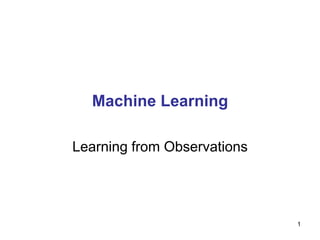The document discusses machine learning and various machine learning techniques. It defines machine learning as using data and experience to acquire models and modify decision mechanisms to improve performance. The document outlines different types of machine learning including supervised learning (using labeled data), unsupervised learning (using only unlabeled data), and reinforcement learning (where an agent takes actions and receives rewards or punishments). It provides examples of classification problems and discusses decision tree learning as a supervised learning method, including how decision trees are constructed and potential issues like overfitting.










































![43
Information gain
For the training set, p = n = 6, I(6/12, 6/12) = 1 bit
Consider the attributes Patrons and Type (and others too):
Patrons has the highest IG of all attributes and so is chosen by the DTL
algorithm as the root
bits
0
)]
4
2
,
4
2
(
12
4
)
4
2
,
4
2
(
12
4
)
2
1
,
2
1
(
12
2
)
2
1
,
2
1
(
12
2
[
1
)
(
bits
0541
.
)]
6
4
,
6
2
(
12
6
)
0
,
1
(
12
4
)
1
,
0
(
12
2
[
1
)
(
I
I
I
I
Type
IG
I
I
I
Patrons
IG](https://image.slidesharecdn.com/ai4-231204110826-16c6df38/85/ai4-ppt-43-320.jpg)

![45
Measure of Impurity: GINI
(CART, IBM IntelligentMiner)
• Gini Index for a given node t :
(NOTE: p( j | t) is the relative frequency of class j at node t).
– Maximum (1 - 1/nc) when records are equally distributed among
all classes, implying least interesting information
– Minimum (0.0) when all records belong to one class, implying
most interesting information
j
t
j
p
t
GINI 2
)]
|
(
[
1
)
(
C1 0
C2 6
Gini=0.000
C1 2
C2 4
Gini=0.444
C1 3
C2 3
Gini=0.500
C1 1
C2 5
Gini=0.278](https://image.slidesharecdn.com/ai4-231204110826-16c6df38/85/ai4-ppt-45-320.jpg)















